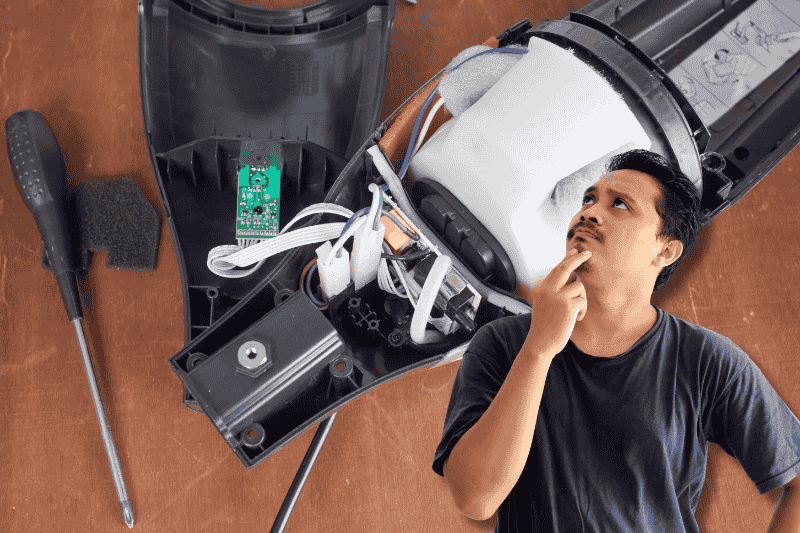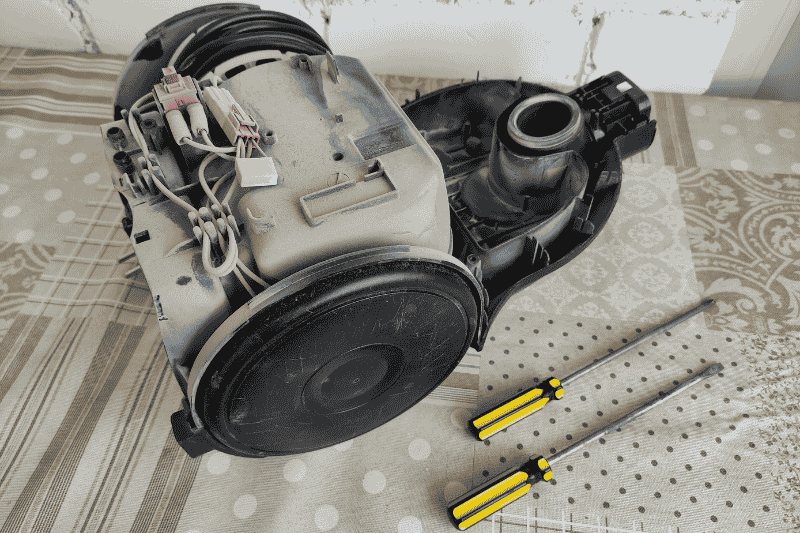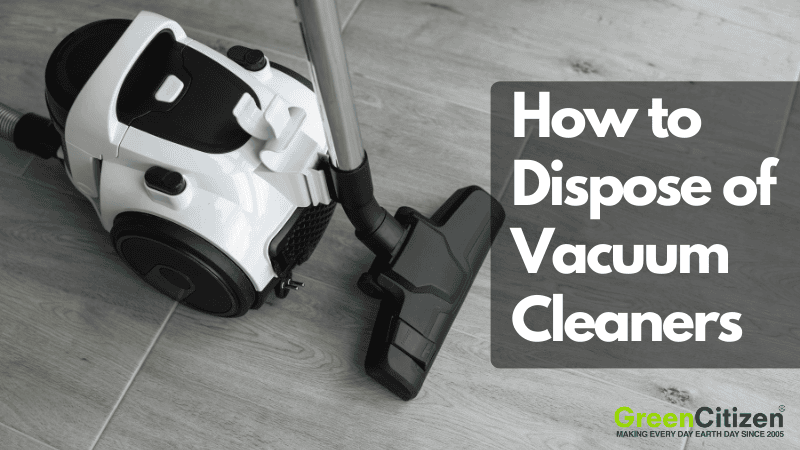Got an old vacuum cleaner gathering dust in the corner? Whether it’s broken, outdated, or simply unwanted, figuring out what to do with an old vacuum cleaner isn’t always clear. Tossing it in the trash might feel easy, but in many states, it’s illegal.
Most vacuum cleaners are made of plastic, metal, motors, and wiring—materials that qualify as e-waste and need proper handling. If you want to dispose of a vacuum cleaner responsibly, you have better options. Many parts can be reused, recycled, or even donated if the unit still works.
This guide covers exactly how to dispose of a vacuum cleaner, whether it’s broken, outdated, or just collecting dust. You’ll learn about eco-friendly disposal, drop-off recycling programs, donation options, and what to do when your local curbside recycling won’t take it.
Looking to recycle your vacuum cleaner or wondering where to drop it off near you? You’re in the right place.
Key Takeaway: How to Dispose of a Vacuum Cleaner Responsibly
To dispose of a vacuum cleaner responsibly, skip the trash and choose options like e-waste recycling centers, retailer take-back programs, manufacturer trade-ins, or part salvaging. These eco-friendly methods reduce e-waste, comply with disposal laws, and help recover valuable materials from your old vacuum.
Can You Recycle Vacuum Cleaners?
Yes, most vacuum cleaners can be recycled, but not through regular curbside programs. They’re considered e-waste because they contain a mix of plastic, metal, wiring, and electronic components.
Here’s how to tell if your vacuum is recyclable:
- Materials check: Most vacuums include recyclable metals (motors) and plastics (casings).
- Electronic parts: Items like circuit boards and cords require e-waste processing.
- Manufacturer info: Look in the manual or brand website to see if parts are labeled recyclable.
- Model age: Newer vacuums are more modular and easier to disassemble for recycling.
If you’re unsure, don’t toss it. E-waste recycling centers can dismantle and sort it safely. Recycling your vacuum keeps harmful materials out of landfills and supports the reuse of valuable resources.
How to Prepare Your Vacuum Cleaner for Recycling
Before you recycle a vacuum cleaner or drop it off for disposal, it’s important to prep it properly. This makes recycling easier and safer, and ensures hazardous or non-recyclable parts don’t contaminate the process.
Follow these steps to prepare your vacuum for recycling:
- Empty the dustbin or bag: Remove all dirt and debris. If it’s bagless, rinse the bin. For bagged models, discard the bag—these aren’t recyclable.
- Detach all removable parts: Take off the hose, filters, brush heads, and power cord. Some may be recyclable separately. Keep reusable parts like cords if they’re in good condition.
- Sort recyclable and non-recyclable components: Use your manual or the manufacturer’s website to identify recyclable parts. Metals and plastics can usually go to recycling; electronic parts require e-waste facilities.
- Remove anything that can’t be recycled: Foam filters, certain rubber parts, or broken internal pieces may need to go in the trash. Check local disposal rules.
Proper prep ensures vacuum cleaner recycling is efficient and eco-friendly—keeping valuable materials out of landfills.
Where to Recycle Vacuum Cleaners

You can recycle vacuum cleaners at local e-waste recycling centers, participating retailers like Best Buy, manufacturer take-back programs, or through online directories like GreenCitizen’s Green Directory.
Most curbside programs won’t accept them, so you’ll need a certified recycler that handles small appliances and electronic waste.
Here’s a breakdown of your best options:
1. Local E-Waste Recycling Centers
Vacuum cleaners count as electronic waste due to their motors, cords, and circuit boards. Most municipal recycling centers won’t take them through standard curbside programs—but many have dedicated e-waste drop-off facilities.
- Visit your city or county website to check for local e-waste collection events or permanent sites.
- These centers safely extract reusable materials like plastic housings, copper wiring, and metal parts.
- Some offer bulk collection days if you’re recycling multiple appliances.
✅ Why it matters: Certified e-waste centers prevent hazardous components from ending up in landfills and help recover valuable resources.
2. Retailer Take-Back Programs
Major retailers now offer in-store appliance recycling, including old vacuum cleaners:
- Best Buy accepts most small appliances for a fee or under their recycling program.
- Staples may accept compact vacuums depending on location.
- Target and Home Depot sometimes run trade-in or drop-off programs tied to promotions.
Pro tip: Call your local store or check their online recycling policy. Not all locations accept vacuum cleaners.
✅ Why it matters: These programs support closed-loop recycling systems, diverting waste from landfills and reintroducing materials into the supply chain.
3. Manufacturer Trade-In and Recycling
Many vacuum brands—like Dyson, Shark, and Hoover—offer take-back services or discounted upgrades when you return your old unit.
- Visit the brand’s official website and search “recycling program” or “trade-in.”
- Some manufacturers provide free shipping labels for mail-in recycling.
- Others incentivize returns with discounts on new models
✅ Why it matters: Brands that offer end-of-life recycling reduce their product’s total environmental footprint and uphold circular economy principles.
4. Use GreenCitizen’s Green Directory
Need a simple way to find where to recycle vacuum cleaners near you? Use GreenCitizen’s Green Directory — a free tool that lists certified e-waste recyclers by zip code.
- Visit the Green Directory and enter your city or zip code.
- Browse nearby recycling centers, drop-off points, and e-waste facilities that accept vacuum cleaners.
✅ Why it matters: It’s the fastest and easiest way to find reliable vacuum cleaner recycling options—no guesswork, no dead-end searches, just local results tailored to your area.
Can You Throw a Vacuum Cleaner in the Trash?

No, you shouldn’t throw a vacuum cleaner in the trash. In many areas, it’s actually illegal. Vacuum cleaners contain plastics, metals, wiring, and small electronic components that classify them as e-waste.
When sent to landfills, these materials can release harmful chemicals into the soil and water. That’s why many cities have e-waste disposal laws banning electronics from the regular garbage stream.
Instead of risking fines or environmental harm, choose responsible disposal options:
-
Take your vacuum to a certified e-waste recycling center.
-
Drop it off at a local scrap metal facility that accepts appliances.
-
Use retailer take-back or manufacturer recycling programs.

Read More:
What Should You Do with a Broken Vacuum Cleaner?

Even a broken vacuum cleaner doesn’t belong in the trash. Depending on its condition, you may be able to repair it, repurpose parts, or recycle it through an e-waste program.
Here are four sustainable options:
Try Repairing It
Small appliance repair shops or electronics technicians can often fix issues like worn belts, faulty switches, or dead motors. It’s cheaper than replacing the whole unit and extends the vacuum’s lifespan.
Salvage Reusable Parts
Remove hoses, filters, or power cords that still work. Motors can be reused in DIY projects, and some plastic or metal components are recyclable on their own.
Sell Parts Online
Working components like brush rolls, wheels, or dust bins may be in demand. List them on sites like eBay or vacuum repair forums. It’s a great way to reduce waste and earn a few dollars.
Recycle What’s Left
If the vacuum is beyond saving, drop it off at a certified e-waste recycling center. They’ll separate materials like copper wiring, plastics, and circuit boards for proper processing.
Don’t trash your broken vacuum. With a little effort, you can reduce e-waste and give those parts a second life.
FAQ: Vacuum Cleaner Recycling
Vacuum cleaners with electronic components like motors, circuit boards, or wiring should be treated as e-waste. Take them to a certified e-waste recycling center or electronics recycler that handles small appliances to ensure proper disposal.
Yes, many vacuum cleaner parts—like hoses, metal wands, cords, and plastic casings—can be recycled individually. Separate reusable components and bring them to an e-waste facility or scrap recycler for proper handling.
Absolutely. If the issue is minor, such as a worn belt or clogged filter, a quick repair can extend its life. Repairing before recycling reduces waste and often saves money compared to buying a new unit.
Yes, many local e-waste recycling centers, municipal drop-off events, and retailers like Best Buy accept vacuum cleaners. Tools like GreenCitizen’s Green Directory can help you find certified locations near you.
Yes, in many states, vacuum cleaners are considered e-waste due to their electronic components. Disposing of them in the trash may violate local e-waste regulations and result in fines or penalties.
If your vacuum cleaner is still functional, donating it is a great option. Thrift stores, shelters, or donation centers may accept it, giving it a second life while keeping it out of the landfill.
Yes. Brands like Dyson and Hoover occasionally offer trade-in or recycling programs. Check your vacuum brand’s official website or contact customer support to see if these options are available.
Before recycling, remove and discard the dust bag or empty and rinse the dustbin. Detach cords, filters, and accessories. Separate recyclable parts like plastic, metal, and electronics for proper sorting.
Some cities allow bulk trash pickup for small appliances, but many prohibit vacuum cleaners due to e-waste laws. Always check with your local waste management service before placing it at the curb.
Most curbside recycling programs do not accept vacuum cleaners. However, some areas offer special e-waste pickup services or scheduled collection days. Check with your city’s sanitation department.
Use tools like GreenCitizen’s Green Directory to locate certified recycling centers by zip code. You can also contact your local waste management office or search for e-waste drop-off events nearby.
Make the Responsible Choice When Disposing of a Vacuum Cleaner
Every vacuum cleaner eventually wears out—but tossing it in the trash isn’t the answer.
Whether it’s recycling your vacuum, donating a working unit, or salvaging parts for reuse, there are smarter ways to dispose of vacuum cleaners that help reduce e-waste and protect the environment.
By choosing responsible disposal methods, you’re not only complying with e-waste laws—you’re also supporting a circular economy and keeping harmful materials out of landfills.
The next time your vacuum gives out, remember: one small action can make a big environmental impact.
